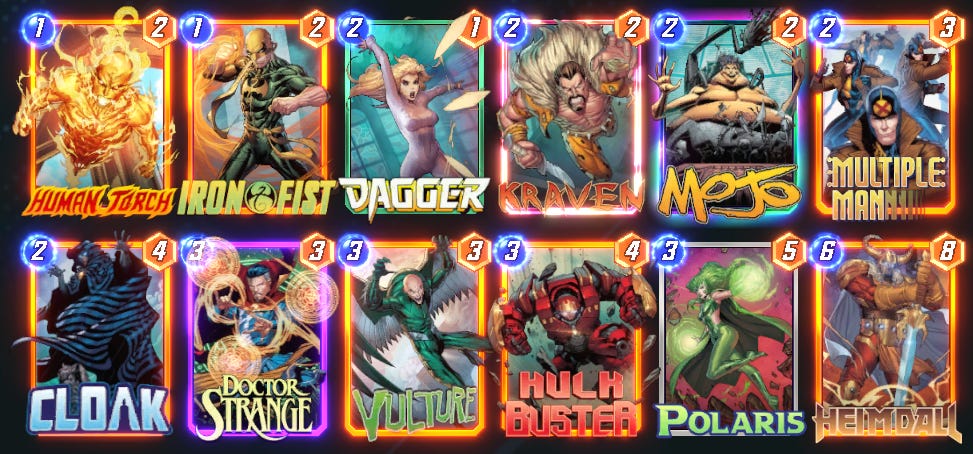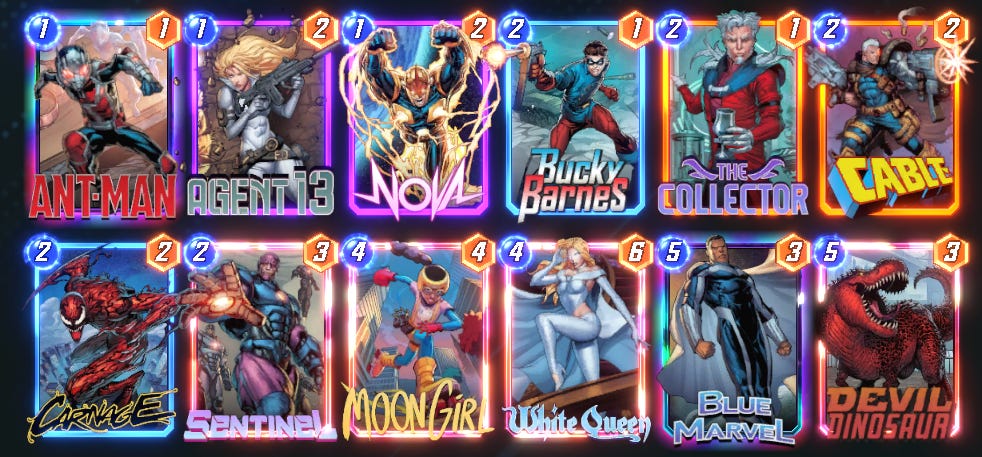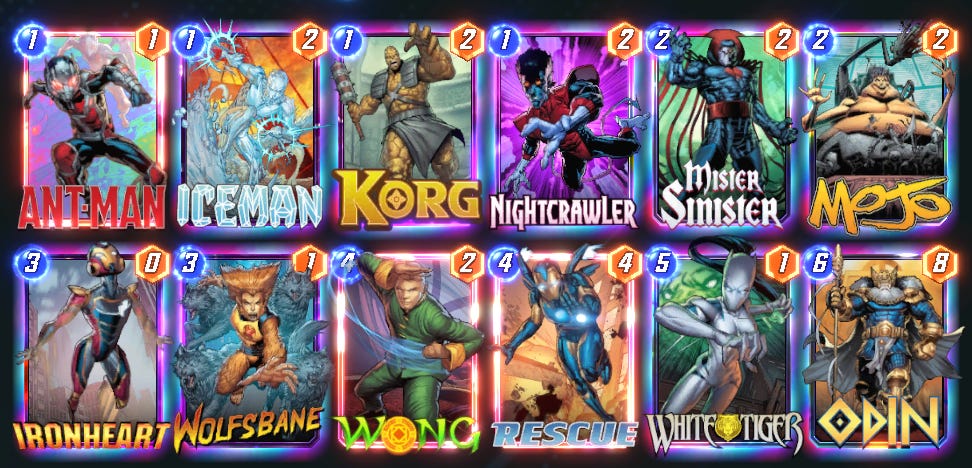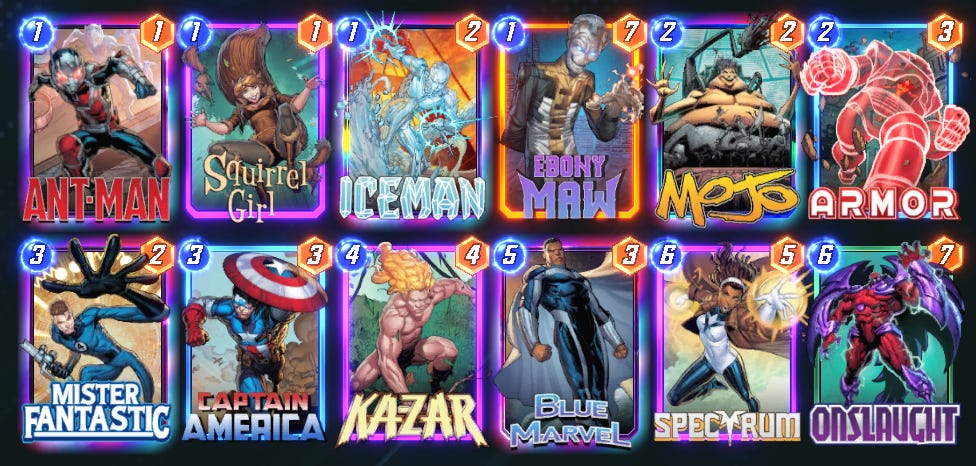[NOTE: This is a pure gaming post, if you’re not into that please do skip it.]
Previously: Marvel Snap Review: Phase 1
At the end of my Phase 1 review, I removed Marvel Snap from my phone.
I am very happy with that decision.
I did then continue to play the game on my computer, via Steam.
I am torn about that decision.
On the one hand, a lot of the games continue to be super interesting, involve interesting decisions, and allow fun to be had. I’ve learned a bunch about games and game design, both the good and the bad. I get to take fun quick breaks when I want one.
On the other hand, the ability to jump into such games is distracting, thinking about what one might do or how one might optimize the game is distracting, and the game is, shall we say, not the best use of my marginal time and thinking. Over time, the game changes less as the rewards get increasingly stingy, as they always do in such games. I am in no danger of spending any money, or getting too ruthless about maximization, but the brain space occupation even without my phone remains real.
Now that the days have gone by, and enough credits have been spent that Pool 1 has become Pool 2 and now Pool 3, it seems worth checking in once again to see what observations seem salient.
My assessment of the game has not much changed – it is who we thought it was.
Mostly, anyway.
The Correct Response to Snaps Is To Fold a Lot
If someone snaps, you should probably fold.
Have I won plenty of games where my opponent snapped and then it turned out to be either a misclick, a bluff, a bot or something really weird? Yes, of course.
It is still not the way to bet, especially if it’s not turn 1 or 2. When the vast majority of players snap, they have a damn good reason for doing so. At a minimum, their deck is going to Do its Thing, whatever it is. Often they have something that will blow you out of the water.
Game theory optimal play requires calling a substantial portion of the time on most boards. Ignore that. People almost never bluff. If it wouldn’t be in your opponents’ best interest to bluff you, you aren’t folding enough. If there is a card or sequence they could plausibly have that wins them the game, that’s it. Game over.
One good reason for this is that folding is no fun. Another is that you’ll never know. You never find out what cool thing your opponent had in mind. Presumably at the highest levels this gets off set by the ‘save time’ motivation, but as in poker there is always the temptation to look someone up purely for the knowledge. It doesn’t cost any money.
It is also very easy to fool yourself. Even after writing this section, in the next two play sessions, I bled cubes by being stubborn for absolutely no good reason. Don’t do this.
I believe I would have more cubes and a higher rank if I auto-retreated every time my opponents snapped, including re-snaps, despite this sometimes being obviously wrong.
And yet I keep often not folding. Before finishing this I picked off a clear redouble pure bluff for the full eight, and all that. Who knows. I’m not exactly taking notes.
The Correct Way to Snap is When They Will Let You
Things are not in equilibrium. Opponents do reasonable things in response to a snap. Between curiosity, stubbornness, faith in their decks and wanting to complete quests, and general ‘all right, sure, let’s go’ energy, they are not going to give up all that often early on.
Later on, they are going to give up only hands you can beat, and often lose one cube instead of two with them, if they can tell what is coming. The turn 5-6 double, after you’ve already revealed why they are dead, is only worth doing if they are playing at I-suspect-a-bot levels of awful, or if what you’d need to have to win is quite narrow. If you have exactly Shang-Chi or Enchantress or Cosmo or what not and that is the only way you could win, then sure, go for it. If it’s simply ‘I have exactly what you think I have and I know you can’t beat that’ then don’t snap.
Earlier on one can be more aggressive, and you can make a bunch of turn 2-3 doubles once you know you’re going to do something good so long as you don’t get stubborn later. If the enemy snaps back, take the hint.
Collector’s Tokens Made Things a Lot Harder
There was a sea change the moment collector’s tokens became available. Suddenly everyone had access to more or less three cards of their choice without this impacting their collection level. If they were already 1k-level or higher, make that six cards. Or they could spend those points on Series 5-6 cards. Usually She-Hulk.
The season cards have the same problem. When someone buys Black Panther or Silver Surfer, this doesn’t change how they get matched up as far as I can tell. However, the decks those cards enable are substantially better than their alternatives until you get pretty deep into Pool 3. The same goes for She-Hulk. She’s both game and fourth-wall breaking, and it’s rather frustrating playing a betting game where your opponents have access to hands that beat everything you can have, or everything except silver bullets, and they can know this.
It also forces players to specialize, making one of their strategies better than other options.
In my case, I can build a halfway decent Wong deck right now because I spent tokens to snag Wong out of the shop, despite not being able to ramp with it because of lacking Black Panther and Doctor Doom. Whereas I lack at least one key card in decks my opponents play, such that my other decks all feel like they’re missing a step.
After that, I have to play decks that I can happen to support. I can play a halfway decent movement deck because I happen to have Dagger and Human Torch. Other than that, I can keep playing Pool 2 decks, or play decidedly inferior versions of things because key cards are missing. I could get one Pool 4 card with all of my collector’s tokens. Pool 5? No sale.
When you take a deck and remove its best draws, then play with a doubling cube, you have a problem. You never have it. Yes, you can bluff things you don’t own, but when they call you the best word to describe your game is ‘toast.’
We used to have this thing in such games called ‘trading.’ That is how my game, Emergents (play beta for free now at the link and all that), plans to work. All solutions that don’t involve trading have some version of these problems.
On reflection, I prefer systems like Hearthstone, where your ‘collection level’ is ignored. If you are a better player than a quest grinder or pack purchaser, you play against worse players with better decks. If the reverse, the reverse. The thing where it tries to match both at the same time feels more like running in place.
What I like even more than that are different user-chosen levels of challenge, at which a player can choose their own goals and definition of success. As you step up to bigger events things get tougher, and maybe your goal is to win some of your games. Sometimes a night out where you finish 2-2 is a grand victory. Other times 5-2 is a huge disappointment. I do realize this sacrifices simplicity, and for many (most?) players it generates feel-bad.
This is unfortunate. We are mostly stuck with the basic queue where everyone wins 55% percent of the time, and there is a lot of the Nothing Matters running around.
I wonder what this says about broader things like inequality.
Matchmaking Rules Everything Around Me
If a game uses a matchmaking system that ensures everyone wins half the time in the long run, everyone will win half the time in the long run. In a very real sense, nothing matters. Adding in some bots so that everyone wins 55% or 60% of the time is the same thing. It changes nothing.
I don’t know the exact internals of the matchmaking system being used, beyond it trying to match collection level and clearly paying a bunch of attention to your rank.
What that meant in effect was that as my collection level went up the game got harder. Since most cards do not make your best decks better, that means that by default as you unlock cards the game gets harder and more frustrating, except that occasionally you get a jump. Which is weird. Magic Arena had some similar dynamics for new accounts.
However, it also means Marvel Snap is Pay to Win substantially more than it appears.
Or at least, Pay to Have a Higher Number of Cubes, since the algorithm will get you back down to your normal win percentage soon enough regardless.
You see, when you buy a Season Pass and are given a super powerful character, it does not increase your collection level.
Mostly you have to let such things not bother you. I mean, who cares? Still.
The ranking system knocks you down 30 ranks, or 270 cubes, on a reasonably regular basis. So either you accept that you’re going to always be low-ranking (on the minus side you won’t get that much challenge or random fake acclaim, on the plus side, you’ll win a lot), or you are going to be doing a lot of grinding.
The Chromatic Enhancements Are Very Much the Goggles
Aside from variants, at least. They do nothing. I literally still have never noticed that someone got a (deep voice) Shiny Logo. I do occasionally technically notice when a card gets the Infinite shine, but it’s kind of the least interesting foil/gold I’ve seen?
The whole ‘collect boosters’ subgame is purely Extra Steps. You can choose which cards to click on. It won’t change anything, other than a tiny boost for clicking on each card once when you can. It’s a chore, it does nothing, it’s annoying.
The variants are different. That is not something I care about, and I’ve never chosen to use one, but I understand. Those can be cute. They are artistic. I’m not mad at them.
The Economy
Thus, things get super simple. Your collection level is min(enough games, enough quests). If you don’t play enough games, that’s a limiting factor. If you do, it’s all quests to get credits and track progress that gets you credits. Which give you upgrades (again, extra steps) which give you collection levels (steps) to get random new cards. Joy.
Or often not joy. Opening a card you don’t want in Pool 3 feels quite bad. Your opponents decks get better permanently, you… get a bad card out of your pool for later. Joy. Sigh. Whereas, thanks to ‘pity’ systems, getting a random variant card instead doesn’t sting.
The math says you pay 50 credits per level except for the first time on each variant or card, so each of those gives a 25 credit discount at the back end. You need 12 collection levels per cache in the long run, so you need 600 credits per cache. If you open 4 caches, you’ll get 1 card (25 credit discount), probably 1 variant (25 credit discount), about 350 credits and 100 collector tokens. So roughly you pay 2000 credits per card, and every 10 cards you get one of your semi-choice or you can save that to buy the expensive stuff.
Long term, you should only buy the expensive stuff, since otherwise you’ll eventually get 600 of your 1000 tokens back and all you’ll have to show for it is a rental. Still, that can be quite a long term rental, so it seems fine if there’s something that helps a lot, especially early in Pool 3.
Eventually, you’ll be getting 700 tokens per 2000 credits, so you’ll need about 15,000 credits per card in Pool 5. It is not obvious that a free player will be able to keep pace with the rate of new premium releases, even if they always complete all daily quests and chapters.
What about your gold? Some players said you should refresh your quests. It seems clear that this is slightly wrong at minimum. Buying a package will give you a better conversion rate, if you are willing to save up for a package. You also get some cool trinkets, and can wait for a package whose trinkets you like and has a good bonus rate. The extra collectors’ tokens here do seem like a pretty big bonus, and again advancing collectors’ tokens without collection level is good for winning.
Deck and Card Impressions
The game has various Good Things To Do, and various individual Good Cards. Your goal is to combine them together as best you can.
At first, that means ‘play your best cards with a reasonable curve.’
By the end of Pool 2 that has shifted to ‘play a cohesive strategy based around something powerful.’ So basically pick one or in some combinations two from Reveal, Destroy, Discard, Collector, Movement, Ongoing and Zoo, and maybe include 1-3 silver bullet cards.
Not all of these are created equal. Most are mostly traps that don’t do enough unless you have their key Pool 3 cards.
For pure Pool 2, I don’t think anything except Collector, Ongoing Zoo or Reveal are actually any good as your main focus.
Discard decks with Dracula or with Hela and Ghost Rider in Pool 3 are doing something reasonable, whether or not it’s top tier. The Pool 2 decks that try to discard Apocalypse and then play him are awful. Their best draws aren’t that powerful. They trip over themselves a lot. Apocalypse is mostly ‘here look I have The Hulk in my hand and got to skip a discard, why don’t you play around him.’ Deck was better with Strong Guy instead but still woefully underpowered.
You can play a tiny Destroy package (Bucky Barnes and Carnage, maybeNova or Deathlok) in Collector or maybe Zoo if you want to, but the full package seems bad and I was repeatedly and profoundly unimpressed. The payoff simply is not that great. Especially telling is how often people seemed to get excited to destroy Nova when the payoff was something like +2 power. If you knew enough to wait until later, it seemed, you also knew enough to play something else.
Movement can be fun and interesting and different, but with only Vulture and Multiple Man as payoffs it doesn’t actually do enough. If you pick up a quick Human Torch then you can do things with it in early Pool 3, with or without the other upgrades. Polaris is a new addition since I just got her, replacing Nightcrawler.

I’ve seen builds that cut the Multiple Man and hulk Buster package, and I am deeply confused by this, you need all the chances you can to get a big power engine. I’ve been unhappy with Forge, largely because he doesn’t work with Iron Fist, but he’s not terrible.
Here is where I am on Collector given what I have, and what I’d play right now if I was back fully into Pool 2:

Reveal gets a huge upgrade once you find Wong, then another upgrade if you actually have its high end. Until then, you still have a reasonable deck. Collector with Sentinel, Cable, Moon Girl, White Queen, Blue Marvel and Devil Dinosaur seems fine too, and there are some open slots that can mostly be whatever. Lately I’ve been putting in the small destroy package and that’s been working better than playing generic cards there.
I’ve been running this as my Odin deck now that I have Wong:

Many builds have few if any 1s and 2s, which I found to be a large mistake. It means you can’t get much value out of Ironheart or Wolfsbane on 3, which means you’re entirely dependent on doing your high-end thing and a pure Tiger-Odin finish often gets outclassed. In particular Mister Sinister solves a lot of problems with slow starts and has a lot of good locations to hit, especially Gamma Lab and The Raft.
It also means you lack control over where your Tigers go. One thing I’ve appreciated a lot is the ability to fill up one location so you don’t have to roll the dice on where a Tiger or two will land. Obviously if you get the full six that’s better, but you don’t lose many games to that problem. Mojo is a flex slot, and could plausibly be any number of other generic cards like Daredevil, Armor or Scorpion, or you can do what a lot of people do and run Storm instead, especially if you don’t have Rescue and Wong so you’re using Jessica Jones instead, I wouldn’t run Storm without Jessica Jones, but Rescue works well with Wong where Jessica doesn’t, especially now that you’re likely to have a one drop for that turn, that often you use to fill one lane so the turn 6 Tigers go to the other.
Zoo of course is the ‘real’ deck for Pool 2 by all accounts, except that it’s the ultimate yawn fest and you seem like you’re always at the mercy of the other player, next man up would probably be Nightcrawler before Korg. Eventually the Patriot builds seem clearly way better, but I don’t have the cards for that.

As these notes suggest, your experience in Pool 3 is going to be deeply colored by which parts of Pool 3 are unlocked for you, and which are not, including how you choose to spend your precious collector tokens. There are a bunch of cool things to do if you get the right cards. There are also things that sort of work with only some of the right cards.
A lot of cards seem like great designs in that they open up a cool option to play with, and it’s a shame that they’re locked behind so much of a grind. The last card I opened as I finished writing this was Spider-Man, which is definitely one of these. Lots of fun things to try there.
One can compare this to Magic or Hearthstone, and ask how good a job Snap does with ‘budget’ decks. If there were trading in Snap, I think they would have done a fantastic job with this balance. Without trading, it still does not seem too bad in practice, especially given the whole ‘you will draw each card more often than not’ dynamic where you really miss anything you don’t have. The ability to slot in a silver bullet card or two in the last slots you’re missing helps as well. Players are doing a diversity of things, and it matters much less whether or not that decision was wise. If anything, Magic suffered from people doing the Standard Thing, especially playing aggressive red decks, more than made sense for them to do. I think many of them felt bad about not trying to maximize in that way, and it made the experience worse all around.
The Real Question
The real question has not changed.
You have some amazing core game play and core game design, and a well built card pool. You have an obnoxious economic and competitive model built around systems that hijack brain attention.
What is the play? Keep playing regularly? Find a way to play less often? Uninstall fully?
I don’t know. It feels close. In particular, it is very hard to tell whether it is actually reducing the amount of work, especially deep work, I am able to do. I have long since accepted that I need frequent breaks of various types and that a large portion of each day is not going to be all that productive, and that trying to change that for more than a week or so at a time is not going to work.
Thus, it comes down to a few questions and counterfactuals. What would I play or do instead? Would it be substantially less or more distracting? Would it, in exchange, be less or more refreshing and invigorating? Would it also help me in other non-obvious ways, perhaps, in a way that Snap isn’t doing at this point? Snap provided some big insights, but it seems unlikely on the marginal time spent to provide much more.
If I can keep the game contained and have it not be a distraction outside of its little window, then it seems worthwhile. If not, then no. So that’s one big key. The other is what I’d put in its place. I’m always going to want something there, and if it isn’t at all distracting then is it even any good?
Recently the game Snap effectively replaced is Storybook Brawl, since Brawl no longer offers tournaments as motivation. That has given me more flexibility, as Brawl requires a 30+ minute time commitment and can lead to not wanting to be interrupted, whereas Snap lacks such issues.
I definitely miss tournaments. What is out there that I can consider for that? I am half-jokingly considering learning Dragon Warrior Randomizer.
What am I missing out on when I have a ten minute window before a meeting, and I play a few games of Snap instead of doing something else? Is it possible to do that and keep one’s deep work properly intact?
This is where public commitments are helpful.
At the end of Phase 1, I removed Marvel Snap from my phone.
At the end of Phase 2, I am committing to not play Marvel Snap for the rest of the day once all quests are cleared and there are enough boosters for all available credits, and not playing before doing everything in my morning update cycle. Playing a deck that doesn’t have the right drops in it to complete any quests, or otherwise intentionally avoiding quest completion. is cheating, and long-term stuff doesn’t count unless there’s some risk it might not happen. Exceptions are I am doing something participatory like streaming, or in the future playing against a friend or in a tournament. Last two days of a cycle I can grind to finish current rank.
We will see what Phase 3 brings.
My friend and I played because it looked like a very good rendition of a simple thing. And it was. We both stopped, because (translated) we didn’t want to get got. The last thing he said to me about it was that “it feels amazingly good to body someone after they snapped for 8” and I think that dynamic is completely sufficient to explain why I, too, would:
When you win, it’s awesome. When you lose, it was just cubes. Your utility is not even close to linear in cube difference. That’s my read.